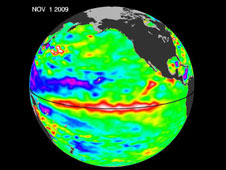 El Niño is experiencing a late-fall resurgence. Recent sea-level height data from the NASA/French Space Agency Ocean Surface Topography Mission/Jason-2 oceanography satellite show that a large-scale, sustained weakening of trade winds in the western and central equatorial Pacific during October has triggered a strong, eastward-moving wave of warm water, known as a Kelvin wave. In the central and eastern equatorial Pacific, this warm wave appears as the large area of higher-than-normal sea surface heights (warmer-than-normal sea surface temperatures) between 170 degrees east and 100 degrees west longitude. A series of similar, weaker events that began in June 2009 initially triggered and has sustained the present El Niño condition.
El Niño is experiencing a late-fall resurgence. Recent sea-level height data from the NASA/French Space Agency Ocean Surface Topography Mission/Jason-2 oceanography satellite show that a large-scale, sustained weakening of trade winds in the western and central equatorial Pacific during October has triggered a strong, eastward-moving wave of warm water, known as a Kelvin wave. In the central and eastern equatorial Pacific, this warm wave appears as the large area of higher-than-normal sea surface heights (warmer-than-normal sea surface temperatures) between 170 degrees east and 100 degrees west longitude. A series of similar, weaker events that began in June 2009 initially triggered and has sustained the present El Niño condition. This image was created with data collected by the U.S./French satellite during a 10-day period centered on November 1, 2009. It shows a red and white area in the central and eastern equatorial Pacific that is about 10 to 18 centimeters (4 to 7 inches) above normal. These regions contrast with the western equatorial Pacific, where lower-than-normal sea levels (blue and purple areas) are between 8 to 15 centimeters (3 and 6 inches) below normal. Along the equator, the red and white colors depict areas where sea surface temperatures are more than one to two degrees Celsius above normal (two to four degrees Fahrenheit).
"In the American west, where we are struggling under serious drought conditions, this late-fall charge by El Niño is a pleasant surprise, upping the odds for much-needed rain and an above-normal winter snowpack," said JPL oceanographer Bill Patzert.
For more information on NASA's ocean surface topography missions, see http://sealevel.jpl.nasa.gov/; or to view the latest Jason data, see http://sealevel.jpl.nasa.gov/science/jason1-quick-look/.




No comments:
Post a Comment